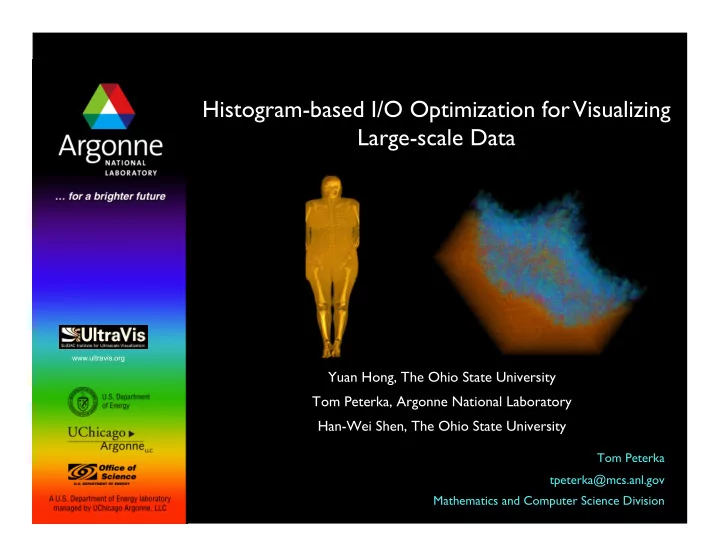

Histogram-based I/O Optimization for Visualizing Large-scale Data www.ultravis.org Yuan Hong, The Ohio State University Tom Peterka, Argonne National Laboratory Han-Wei Shen, The Ohio State University Tom Peterka tpeterka@mcs.anl.gov Mathematics and Computer Science Division
I/O Optimization for Visualization � Motivation Parallel I/O is Performance of parallel necessary, but visualization bound by Effect of space-filling not sufficient Visualization techniques data movement curves diminishes as resulting in sparse traversal can process count exacerbate the problem increases Idea Consider both visibility culling and spatial locality when ordering data. Sample a variety of view directions and construct a histogram of visible blocks, independent of transfer function. Reorder data accordingly to balance load across file servers and produce contiguous access. SC09 Ultrascale Visualization Workshop November 16, 2009 Tom Peterka tpeterka@mcs.anl.gov 2
Related Literature � Background Visibility culling Gao et al., Visibility Culling Using Plenoptic Opacity Functions for Large Volume Visualization, Vis ‘03. Zhang et al., Visibility Culling Using Hierarchical Occlusion Maps, SIGGRAPH ‘97. Out of core methods Pascucci and Frank, Global Static Indexing for Real-Time Exploration of Very Large Regular Grids, SC01. Isenburg and Lindstrom, Streaming Meshes, Vis ‘05. Collective I/O Thakur et al., Optimizing Noncontiguous Access in MPI-IO, Parallel Computing ‘02. Smirni et al., Algorithmic Influences on I/O Access Patterns and Parallel File System Performance, ICPADS ’97. SC09 Ultrascale Visualization Workshop November 16, 2009 Tom Peterka tpeterka@mcs.anl.gov 3
Algorithm � Overview Algorithm overview consists of: partitioning data, sampling views on a view sphere, computing view histograms for each view direction, concatenating view histograms into feature vectors, grouping similar feature vectors into clusters, and striping data blocks onto parallel storage according to the clusters. SC09 Ultrascale Visualization Workshop November 16, 2009 Tom Peterka tpeterka@mcs.anl.gov 4
Compute View Histograms and Feature Vectors � Classify data in all view directions 128 bytes SC09 Ultrascale Visualization Workshop November 16, 2009 Tom Peterka tpeterka@mcs.anl.gov 5
Feature Vector Computational Cost � Scalable parallel implementation The variance across all histogram bins and all view directions as a function of the number of view directions. The variance changes slowly after 256 sampled views, indicating that more samples are not necessary. Viswoman dataset. Total preprocessing time for supernova dataset, from 256 to 2048 cores, on Argonne’s BG/P system. The dataset is 276 GB, and 1024 views were sampled in under seven minutes. SC09 Ultrascale Visualization Workshop November 16, 2009 Tom Peterka tpeterka@mcs.anl.gov 6
Organizing Data in Storage � Layout parameters Block size of 16^3 has best I/O I/O time vs. stripe size for Viswoman performance for Viswoman dataset, dataset. Optimal stripe size is that of irrespective of process count. Block size is average cluster size that results from chosen to be a multiple of the read buffer clustering feature vectors. size, 16 KB in our default MPI-IO implementation. SC09 Ultrascale Visualization Workshop November 16, 2009 Tom Peterka tpeterka@mcs.anl.gov 7
End-to-End Performance � Test conditions, datasets, total and component time Test conditions: System: IBM BG/P at Argonne National Viswoman volume rendering Laboratory, PVFS file system performance with histogram- optimized method Viswoman dataset: 512x512x1728, 2-byte short # Procs I/O time Render Composite Total ints, 16^3 blocks (s) time (s) time (s) time (s) 64 4.37 1.02 1.20 6.59 Richtmyer-Meshkov Instability (RMI) dataset: 128 3.66 0.46 0.80 4.92 2048x2048x1920, 1-byte chars, 32^3 blocks 256 3.43 0.33 0.80 4.56 512 1.77 0.20 0.60 2.57 Supernova dataset: 3456x3456x3456 1024 0.91 0.12 0.50 1.53 supersampled, 4-byte floats, 16^3 block size SC09 Ultrascale Visualization Workshop November 16, 2009 Tom Peterka tpeterka@mcs.anl.gov 8
Comparison to Space-Filling Curves � I/O time for three datasets Viswoman RMI Supernova Top: I/O time for three datasets. Bottom: compositing, rendering, I/O time for supernova. In all test cases, the histogram-optimized method performs better than canonical organization and space-filling curves. Supernova Supernova Histogram optimized Z curve SC09 Ultrascale Visualization Workshop November 16, 2009 Tom Peterka tpeterka@mcs.anl.gov 9
Comparison to Hilbert Curve � Across view directions Across time-steps Standard deviation of I/O time in RMI across I/O time across 64 time-steps of RMI with 256 random view directions demonstrates 512 processors demonstrates consistent consistent performance over variety of view performance over a time-varying dataset. conditions. SC09 Ultrascale Visualization Workshop November 16, 2009 Tom Peterka tpeterka@mcs.anl.gov 10
Independent of Transfer Function � Various opacities, single and multimodal I/O time for histogram-optimized and Hilbert curve for supernova dataset rendered with a variety of transfer functions. Transfer functions were generated synthetically using a nonlinear computation that stochastically produces one or more modes. SC09 Ultrascale Visualization Workshop November 16, 2009 Tom Peterka tpeterka@mcs.anl.gov 11
Histogram-based I/O Optimization for Visualizing Large-scale Data Successes Limitations / Future work - Scale to higher number of processes - Data organization based on visibility culling and spatial locality - Zoom - Scalable feature classification time - Higher-dimension transfer functions - Other storage and file systems - Improved volume rendering performance over space-filling curves www.ultravis.org - Transfer function independence - Heuristics for usage Tom Peterka Acknowledgments: tpeterka@mcs.anl.gov Argonne Leadership Computing Facility US DOE SciDAC UltraVis Institute Mathematics and Computer Science Division
Recommend
More recommend